Gustave Caillebotte: The Painter’s Eye
By • August 17, 2015 0 1791

We are welcomed into the National Gallery of Art, just past its pantheonic atrium, by the paintings of Manet, Renoir, Pissarro, Monet, Cassatt, Degas, Morisot — those visionaries who built a bridge between the classical tradition and the modern era.
The early Impressionists created some of the first work within the Western canon that does not require a religious, historical or scholarly key to be fully appreciated. These are secular images of mundane humanity — a woman reading a newspaper, a man staring out the window — and scenes of fleeting naturalism, like a sunset over an open field or fruit scattered across a wooden table.
Strange to think that this could be considered an act of defiance, but in the age of the French Academy the subject matter of art floated on a lofty plane; the depiction of laborers, pedestrians, dirty urban street scenes and ordinary wheat fields was renounced as vulgar, even depraved.
Say what you will about the brushwork and color palettes of the Impressionists (which are indeed heart-stopping), the real enduring power of that brassy and quarrelsome gaggle of painters is their work’s ability to connect to a mass audience — now for well over a century.
For two reasons, then, one is stunned to encounter the work of Gustave Caillebotte in the National Gallery’s current retrospective, “Gustave Caillebotte: The Painter’s Eye,” on view through Oct. 4. First, his work is immediately iconic, with many pieces as bracing and unforgettable as established Impressionist masterpieces such as Monet’s “Woman with a Parasol,” which hangs nearby. Second, and in light of this, it is baffling that no one seems to have heard of him.
(It should be noted that Caillebotte is far from unknown among the many artists and curators with whom I have spoken. In fact, he is a frequent favorite, a sort of beloved secret.)
Poised to rectify Caillebotte’s status among the leaders of early Impressionism, the National Gallery exhibition tackles this conundrum head-on, revealing the odd circumstance that underscores Caillebotte’s relative anonymity: He came from money.
Caillebotte’s family owned a successful textile business. Being financially secure meant that he never needed to make money through his paintings. Because he did not sell his work, relatively few of his paintings have entered public collections. Furthermore, as a contemporary of Degas, Monet, Renoir and others, he was also an art collector. Upon his death much of his sizable collection was willed to the state, becoming the cornerstone of France’s national collection of Impressionism. Ironically, this bequest overshadowed his own reputation as an artist.
With his paintings shielded from public view, Caillebotte’s significant role in the development of Impressionism receded. He remained largely undetected until a series of exhibition late in the 20th century.
However, when finally confronted with his work, all this history suddenly seems like a trivial footnote. It is a feeling that takes hold the moment you enter the exhibition galleries, with the very first painting on the right, “Portrait of a Man.” The cool quality of the light as it breaks across the planes of the subject’s face and vest, with the delicate lace curtain and iron window guard so succinctly rendered, shows an artist in complete control of both medium and style.
There is also a tremendous sense of soul to the man in the painting. This chilling distinctness of inner life, of self and spirit, reverberates through of all of Caillebotte’s portraits. But to speak of the painter’s distinctive qualities is to say nothing of his noteworthy artistic evolution.
Caillebotte began his career exploring a Paris in transition, detailing the city as it was transformed by large-scale renovations, beginning in the 1850s, guided by Baron Haussmann. With immense street scenes and glimpses through parlor windows in his portraits, he examined the city’s new steel bridges, wide boulevards, ample sidewalks and uniform buildings. Through his still-life paintings of the Parisian markets — the butcher shops, patisseries and produce stands — we see the city’s lush offerings. Surprising and wonderful, these works are the missing link between the vanitas of near-nauseating banquet pieces from the Dutch Golden Age and Wayne Thiebaud’s window displays of cakes, pies and confections.
After showing with the Impressionists in 1882, Caillebotte stopped exhibiting regularly with them, and by the end of the decade he had moved from the city to the suburbs. There, he painted boating and garden scenes, and ultimately devoted himself to the pursuit of landscapes (likely influenced by his increasingly close friendship with Monet).
?As you proceed through the exhibition, you can actually watch as his brushwork loosens and his colors leave the pearly blue hues of the city behind, becoming far less restrained.
In the final gallery, there is a painting called “Linen Out to Dry, Petit Gennevilliers.” A small cottage sits on the edge of a river at what initially looks like the base of an unfinished mountain range. Then you realize that what you see are not mountaintops but white linens billowing in the wind. It is nearly a study rather than a finished painting — in many areas the raw canvas is visible between the loose brushwork — except that you can taste the air of the countryside.
As Impressionism goes, the conjuring of some Transcendental ether is quite a profound, if ridiculous-sounding, achievement. But it is one of the pleasures of this exhibition to get caught up and whisked away by the discovery of these new and eternal moments of painting.

